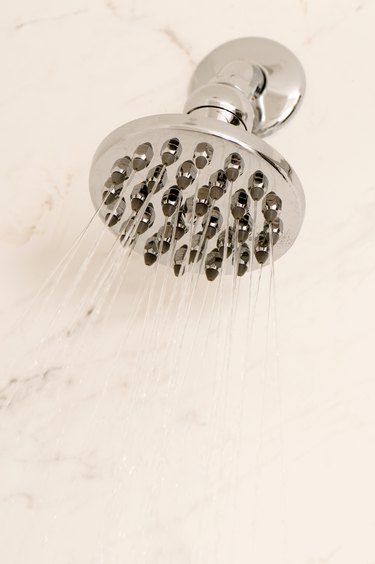
Plumbing leaks anywhere in the house can potentially damage surfaces and interior structures in your home, so any time you find one, you should repair it promptly. When you notice leaking behind the shower escutcheon plate, it's usually because the shower arm is either too loose or it has corroded. There's also an outside chance that the pipe between the shower diverter and the head has developed a pinhole leak or that one of the supply pipe joints is leaking.
Pinpointing the Problem
Video of the Day
You should be able to get a clear idea of exactly where the water is leaking by pulling off the escutcheon and looking through the hole that it covers with a flashlight. Turn off the shower head and turn on the water to maximize the pressure in the pipes. You'll probably find water spraying from the joint between the shower arm and the brass 90-degree elbow to which it's attached. If so, you'll be able to make the repair without much trouble. More problematic is water spraying from the copper pipes themselves. It signifies a poorly-soldered joint or a pinhole leak, and you'll need access to the pipes to make repairs.
Video of the Day
Tightening the Shower Arm
Water spraying from the shower arm connection may simply mean that the arm needs to be tightened, Before you start turning it, however, remember that you have to turn it through a complete rotation, or it will no longer be at the correct angle. You can damage the pipe by turning it too far, so a better strategy is wrap a rag around it to prevent damage and unscrew it with adjustable pliers. Once it's off, wind plumbing tape around the threads, using enough to make four or five layers, and apply pipe dope to the threads of the fitting inside the wall with an artist's paintbrush. When you replace the arm, the joint should be sealed.
Replacing a Corroded Shower Arm
The combination of an old shower arm and a leak often means corrosion, and the remedy is to replace the arm. Corroded arms often break when you try to remove them, however, and you can't put in the new one until you extract what's left of the old one. One way to do this is to tap a long 1/2-inch drill bit into the pipe with a hammer and grip the end with locking pliers. When you turn the bit counterclockwise with the pliers, its teeth should bite into the pipe remnant and unscrew it.
Leaking Pipes
If you notice water leaking from the supply pipe itself, you may have to break through the wall to make repairs unless you have an access panel for the shower plumbing. The repair itself isn't difficult. You simply cut the pipe below the point where it's leaking, solder on a coupling and replace the leaking section of pipe and the brass elbow with new materials. While inside the wall, take a good look at the framing and make sure none of it has rotted. Leave the wall open for a week or so to let the framing dry out.